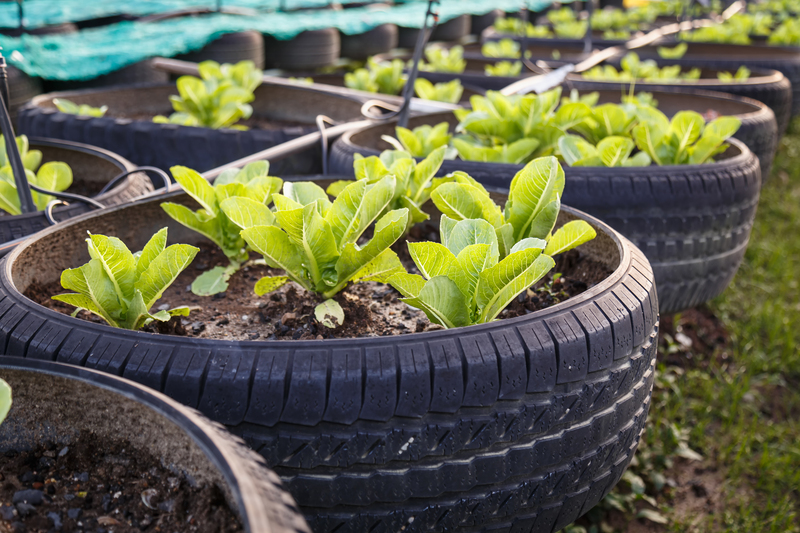How Waste Clearance Services Help Combat Climate Change
Climate change stands as one of the defining challenges of our time. As carbon emissions continue to rise and ecosystems undergo rapid transformations, both individuals and businesses search for practical ways to make a meaningful difference. One often underestimated yet critical aspect is the effective management of waste. In this comprehensive article, we'll explore in detail how waste clearance services help combat climate change, why their role is expanding, and what innovations are shaping a greener future.

Understanding the Link Between Waste and Climate Change
While discussions about reducing carbon footprints may first bring to mind renewable energy or electric vehicles, waste management is an equally significant piece of the puzzle. The way society handles its rubbish directly influences greenhouse gas emissions, impacts natural resources, and determines the overall burden placed on our planet's ecosystems.
Traditional waste disposal methods, especially landfill and open burning, produce substantial amounts of methane and carbon dioxide. Methane, for example, is over 25 times more potent than CO2 in terms of heat trapping over a 100-year span. Therefore, strategic waste clearance strategies and innovations offer unparalleled potential to cut emissions and foster sustainability.
The Crucial Role of Waste Clearance Services
Waste clearance services - from residential rubbish removal to commercial site clearing - are at the heart of modern environmental stewardship. They offer much more than just collection and disposal. Today's industry leaders focus on maximizing recycling rates, minimizing landfill use, and promoting ecological responsibility at every stage.
The Core Functions of Waste Clearance Companies
- Collection & Segregation: Efficient sorting of waste at the source increases the volume that can be recovered, composted, or recycled.
- Recycling & Upcycling: Professional services collaborate with recycling centers to divert materials from landfills and reintroduce them into the production cycle.
- Hazardous Waste Management: Proper disposal of electronic, chemical, and medical waste prevents toxic pollutants from contaminating soil and water sources, while also curbing air emissions from unsafe burning.
- Education & Advocacy: Reputable clearance firms empower clients with knowledge on sustainable practices and policy compliance.
Transforming Waste into Resources
Effective clearance services view waste as a resource rather than a problem. For instance, food scraps and garden debris become valuable compost, while metals and plastics are reclaimed for new products. This circular approach not only prevents landfill expansion but also spares the need for virgin resource extraction, further slashing emissions across industries.
How Does Waste Clearance Reduce Greenhouse Gas Emissions?
The impact of eco-friendly waste clearance runs deeper than meets the eye. Here's how these services break the harmful cycle:
- Reducing Landfill Methane: By diverting organics and recyclables, clearance services limit the anaerobic decomposition that generates methane in landfills.
- Lowering Energy Consumption: Recycling metal, glass, and plastic consumes far less energy than producing materials from scratch - this means fewer fossil fuels burned and less CO2.
- Optimized Transportation: Modern fleets utilize route optimization and low-emission vehicles, reducing fuel use per collection journey.
- Responsible Incineration: When waste-to-energy solutions are employed, state-of-the-art filtration and energy recovery systems drastically limit negative outputs.
- Improved Composting: Organics managed through composting transform naturally, generating rich soil without harmful gases or leachate.
Innovations in Waste Clearance Fighting Climate Change
Advancements in waste management technology further amplify waste clearance's climate benefits. Let's examine a few of the game-changers making headlines:
Smart Sorting and AI-Driven Recovery
Automated sorting facilities, powered by artificial intelligence and robotics, can now separate materials faster and with greater precision than ever before. This maximizes recycling rates and ensures that even complex composites are processed accordingly, keeping more waste out of landfill.
Biogas and Advanced Composting Systems
Modern organics waste clearance often ends with the creation of biogas. Anaerobic digesters convert food and green waste into renewable methane, which can be used as heat or electricity, simultaneously reducing the need for fossil fuel energy and delivering carbon-neutral solutions.
Location-Based Tracking & Digital Reports
Many professional waste clearance services now offer digital tracking and reporting tools. This transparency empowers businesses and individuals to monitor their waste streams, benchmark progress, and set new sustainability goals, driving further climate-conscious efforts.
Zero-Waste Partnerships
Forward-thinking services collaborate with organizations and local authorities to develop closed-loop systems, where waste from one process serves as raw material for another. These partnerships bring us closer to the ideal of zero waste and significantly reduce overall carbon emissions.
Benefits of Professional Waste Clearance Services for the Community
The advantages offered by reputable waste clearance firms extend well beyond environmental protection. They deliver tangible benefits for communities, the economy, and public health:
- Improved Urban Cleanliness: Regular, thorough waste clearance reduces littering, curbs pest infestations, and makes public spaces more inviting.
- Job Creation: The waste management sector is a major employer, with new green roles emerging as technology shifts the landscape.
- Resource Conservation: Efficient recycling means fewer natural resources are depleted, leaving more for future generations.
- Public Health Protection: Proper hazardous waste handling averts outbreaks of disease and minimizes exposure to toxins.
- Boosted Local Economies: By sourcing secondary raw materials locally, municipalities keep more money in their communities.
Waste Clearance Services and Circular Economy: A Perfect Match
The circular economy is a model where products, materials, and resources are kept in use for as long as possible, extracting maximum value before ultimately regenerating them at the end of their useful life. Waste clearance companies are central to this vision, as they:
- Enable reuse by identifying salvageable items for donation, repair, or resale
- Collaborate with manufacturers and local businesses to support take-back programmes
- Provide data on waste patterns to inform better product design and reduced packaging
- Facilitate urban mining, where valuable resources are reclaimed from end-of-life electronics and infrastructure
How Customers Can Maximise the Impact of Waste Clearance Services
Whether you're a business owner, homeowner, or facility manager, choosing the right eco-conscious waste clearance provider is one of the most effective ways to shrink your carbon footprint. Here are some actionable steps to enhance climate outcomes:
1. Choose Certified, Green-Minded Providers
Look for waste companies with recognised environmental certifications, a track record for high recycling rates, and transparent disposal routes. Ask about their landfill avoidance policies and low-carbon solutions.
2. Segregate Waste Properly
Partner with firms that help you sort recyclables, organics, and hazardous material at the point of generation. Correct segregation boosts recycling rates and maximises the value of recovered materials.
3. Support Local Partnerships
Encourage your clearance provider to work with local recycling centres, charities, and upcycling initiatives, reducing transport emissions and keeping resources circulating within your community.
4. Reduce and Reuse Before Disposal
The most effective emissions reductions occur when waste is never created in the first place. Prioritise reuse and only rely on clearance for items that have truly reached the end of their lifespan.
5. Educate and Advocate
Use the reporting and feedback provided by your waste clearance partner to improve internal processes, identify opportunities to cut waste, and share knowledge with your network.
Case Studies: Waste Clearance in Action Against Climate Change
Across the globe, innovative rubbish clearance and waste management projects are making a visible difference in the fight against climate change:
London's Food Waste Revolution
Several UK-based waste clearance companies have collaborated with Borough Councils to implement city-wide food waste collection programmes. Diverted from landfill, this organic matter is sent to anaerobic digestion plants, producing enough renewable gas to supply thousands of homes, and resulting in a significant cut to the city's methane footprint.
Zero-Waste Events in the United States
Leading waste clearance firms partner with event organizers to provide on-site sorting, composting, and recycling stations. At a major music festival in California, 90% of all waste was either recycled or composted, preventing hundreds of tons of emissions from landfill and eliminating persistent litter.
Building Deconstruction Instead of Demolition
Progressive waste clearance businesses in Europe and Canada are deconstructing older buildings piece by piece, salvaging bricks, timber, and fixtures. These materials are then resold or reused, sparing thousands of tonnes of carbon emissions compared to traditional demolition and rebuilding from new sources.
Challenges Facing Waste Clearance and Emerging Solutions
Despite these successes, the sector faces ongoing hurdles on the road towards maximum climate impact:
- Contamination of Recycling Streams: Inconsistent sorting and insufficient education can lead to recyclable materials being landfilled.
- Illegal Dumping: Unregulated clearance actions can result in burning or dumping waste, harming both climate and public health.
- Infrastructure Gaps: Rural or developing areas may lack access to advanced waste recovery centres and clean transportation fleets.
- Market Volatility: Prices for recycled materials can fluctuate, making economics challenging for small or emerging operators.
However, policy interventions, public-private partnerships, and continual innovation are driving improvements. Authorities are introducing compulsory sorting, Extended Producer Responsibility (EPR) laws, incentives for low-emission fleets, and support for local upcycling hubs.

Looking Ahead: The Future of Waste Clearance and Climate Action
As awareness grows and climate targets become more ambitious, the waste clearance industry is set to play an increasingly influential role. Synergies with renewable energy, digital reporting, and global standards will accelerate progress toward zero waste outcomes and net zero emissions. By choosing responsible waste clearance services, we all contribute to a cleaner, greener, and more resilient planet.
Conclusion: Waste Clearance Services as Climate Change Champions
Combating climate change requires a comprehensive approach--government action, research, lifestyle shifts, and crucially, a transformation in the way we view and manage waste. Modern waste clearance services are now on the front lines, providing solutions that span recycling, resource recovery, and landfill avoidance. Their actions, combined with conscious consumer and business choices, drive the circular economy and make a tangible difference in the world's quest for sustainability.
- Reduce what you discard, reuse where possible, and partner with professionals who prioritise climate protection.
- Support innovations in waste sorting, transport, and energy recovery.
- Advocate for community- and policy-level change that values waste clearance's role in climate action.
The more we invest in responsible waste clearance today, the greater our legacy in the fight against climate change will be for future generations.